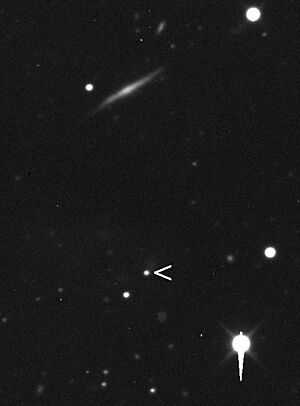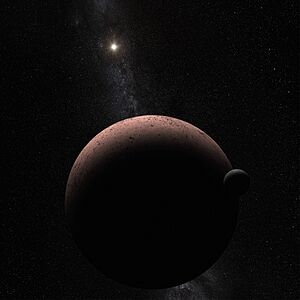Makemake facts for kids

Low-resolution image of Makemake and its unnamed moon S/2015 (136472) 1 by the Hubble Space Telescope, April 2015
|
|
| Discovery | |
|---|---|
| Discovered by |
|
| Discovery date | March 31, 2005 |
| Designations | |
| MPC designation | (136472) Makemake |
| Pronunciation | or |
|
Named after
|
Makemake |
| 2005 FY9 | |
|
|
| Adjectives | Makemakean |
| Orbital characteristics | |
| Epoch May 31, 2020 (JD 2458900.5) |
|
| Earliest precovery date | January 29, 1955 |
| Aphelion | 52.756 AU (7.8922 Tm) |
| Perihelion | 38.104 AU (5.7003 Tm) |
| 45.430 AU (6.7962 Tm) | |
| Eccentricity | 0.16126 |
| 306.21 yr (111,845 d) | |
|
Average orbital speed
|
4.419 km/s |
| 165.514° | |
| Inclination | 28.9835° |
| 79.620° | |
| 17 November 2186 | |
| 294.834° | |
| Known satellites | 1 (S/2015 (136472) 1) |
| Physical characteristics | |
| Dimensions |
(1434+48
−18) × projected (1420+18 −24 km) |
|
Mean radius
|
|
| Flattening | 0.0098 |
| 6.42×106 km2 | |
| Volume | 1.53×109 km3 |
| Mass | ≈ 3.1×1021 kg |
|
Mean density
|
|
|
Equatorial surface gravity
|
< 0.58 m/s2 |
|
Equatorial escape velocity
|
< 0.91 km/s |
|
Sidereal rotation period
|
22.8266±0.0001 h |
| Temperature |
|
| B−V=0.83, V−R=0.5 | |
| 17.0 (opposition) | |
|
|
Makemake (minor-planet designation: 136472 Makemake) is a dwarf planet. It was discovered on March 31, 2005 by a team led by Michael E. Brown, and announced on July 29, 2005.
Contents
Discovery
Makemake was discovered on March 31, 2005, by a team at the Palomar Observatory, led by Michael E. Brown, and was announced to the public on July 29, 2005.
Makemake is the brightest trans-Neptunian object after Pluto.
Name
Makemake was initially known as 2005 FY9 and later given the minor-planet number 136472.
Before that, the discovery team used the codename "Easterbunny" for the object, because of its discovery shortly after Easter.
In July 2008, it was named after Makemake, a creator god in the Rapa Nui mythology of Easter Island in part to preserve the object's connection with Easter.
Orbit and classification
As of April 2019[update], Makemake was 52.5 AU (7.85 billion km) from the Sun, almost as far from the Sun as it ever reaches on its orbit. Makemake follows an orbit very similar to that of Haumea: highly inclined at 29° and a moderate eccentricity of about 0.16.
Its orbital period is 306 years, more than Pluto's 248 years and Haumea's 283 years. Makemake will reach its aphelion in 2033, whereas Haumea passed its aphelion in early 1992.
Makemake is a classical Kuiper belt object (KBO), which means its orbit lies far enough from Neptune to remain stable over the age of the Solar System.
Brightness, size, and rotation

Makemake is currently visually the second-brightest Kuiper belt object after Pluto. It is bright enough to be visible using a high-end amateur telescope.
Its dimensions had initially been measured at (1,502 ± 45) × (1,430 ± 9) km. However, the occultation data was later reanalyzed, leading to an estimate of (1434+48
−18) × (1420+18
−24 km) without a pole-orientation constraint.
The rotation period of Makemake is estimated at 22.83 hours. This rotation period is relatively long for a dwarf planet. Part of this may be due to tidal acceleration from Makemake's satellite.
Spectra and surface
Like Pluto, Makemake appears red in the visible spectrum, and significantly redder than the surface of Eris.
Spectral analysis of Makemake's surface revealed that methane must be present in the form of large grains at least one centimetre in size. Large amounts of ethane and tholins, as well as smaller amounts of ethylene, acetylene, and high-mass alkanes (like propane), may be present, most likely created by photolysis of methane by solar radiation. The tholins are probably responsible for the red color of the visible spectrum.
The surface of Makemake is not homogeneous. Although the majority of it is covered by nitrogen and methane ices, there are small patches of dark terrain whose albedo is only 2 to 12%, and that make up 3 to 7% of the surface.
Atmosphere
Makemake presently lacks a substantial atmosphere. The presence of methane and possibly nitrogen suggests that Makemake could have a transient atmosphere similar to that of Pluto near its perihelion. Nitrogen, if present, will be the dominant component of it.
Interesting facts about Makemake
- Makemake was the fourth dwarf planet recognized. Despite its relative brightness (a fifth as bright as Pluto), Makemake was not discovered until after many much fainter Kuiper belt objects.
- It has a highly reflective surface.
- Makemake has a single discovered moon, S/2015 (136472) 1 and nicknamed MK2.
- Its extremely low average temperature, about 40 K (−230 °C), means its surface is covered with methane, ethane, and possibly nitrogen ices.
- Research shows that Eris, Pluto and Makemake show signs of noticeable geothermal activity and could likely harbor active subsurface oceans.
- It has been calculated that a flyby mission to Makemake could take just over 16 years using a Jupiter gravity assist.
- A Makemake symbol is included in Unicode as U+1F77C: it is mostly used by astrologers, but has also been used by NASA. The symbol was designed by Denis Moskowitz and John T. Whelan.
Images for kids
-
Orbits of Makemake (blue), Haumea (green), contrasted with the orbit of Pluto (red) and the ecliptic (grey). The perihelia (q) and the aphelia (Q) are marked with the dates of passage. The positions in April 2006 are marked with the spheres illustrating relative sizes and differences in albedo and colour.
-
Makemake's orbit outside of Neptune is similar to Haumea's. The positions are as of 1 January 2018.
-
Makemake, indicated with red bars, as imaged by the New Horizons spacecraft in October 2007
See also
 In Spanish: Makemake (planeta enano) para niños
In Spanish: Makemake (planeta enano) para niños
- Astronomical naming conventions
- Clearing the neighbourhood
- International Astronomical Union
- Planets beyond Neptune
- List of Solar System objects most distant from the Sun
- Ocean worlds
- Extraterrestrial liquid water






